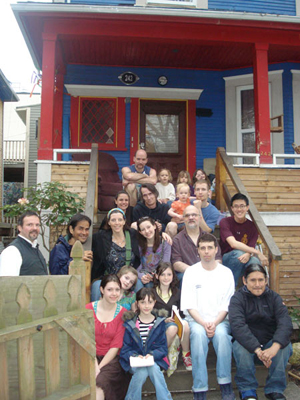
Over the previous three days, The Tyee's "Reinventing Co-ops" panel has explored how a new type of shared equity housing co-operative might blend public and private investment to create affordable family housing in expensive markets such as Vancouver.
Today, the panel of co-op experts assembled by The Tyee debates the merits of merging some of Canada's 2,221 small housing co-operatives into larger multi-property organizations in order to both pool equity and provide a greater measure of security for residents of aging buildings.
Small co-ops unable to expand
"One of the things that the co-op housing movement has wrestled with is: The challenge doesn't end when you close the deal and move in," said Co-op Housing Federation of B.C. director Thom Armstrong. "The additional challenge is: How do you govern and manage that piece once it's built?"
Armstrong then introduced the idea that dominated the group's afternoon discussion. He suggested that the next generation of co-ops "not lock ourselves in" to creating a separate co-operative for each building.
"We've managed over time to organize ourselves into the smallest possible business units that you could imagine," Armstrong said. "Every co-op is a single stand-alone portfolio."
By contrast, he noted that most for-profit and non-profit housing owner/operators have large portfolios of housing.
"I don't want to limit ourselves to thinking of a co-op as a specific housing development," Armstrong said.
"It's interesting to note that there are 2,200 co-op housing boards in this country for approximately 100,000 units," chimed in Nicholas Gazzard, of the Co-operative Housing Federation of Canada. "By my calculation, roughly one in seven people has to be sitting on their board at any one time. And the quality of governance in the co-op housing sector has suffered as a result."
Gazzard offered a contrasting example.
"The housing associations in the U.K. are big," he said. As a result, "They're able to do a combination of affordable rental, market ownerships, and shared equity."
Gazzard said the big British housing associations such as Guinness and Peabody are able to function more like developers.
"One of the things they're able to do because of their size is trade. They will sell housing assets to acquire or develop others that suit the changing needs of their population groups," he said.
"In this case, size really does matter," Gazzard continued. "You can't do much to leverage a 50-year-old housing co-op that's built on a non-profit basis. But you could if you're an owner or a controller of a number of co-op properties."
Big co-ops better able to rebuild
Darren Kitchen, of the B.C. Co-op Federation, provided a specific example of an aging co-op building that needs to be rebuilt.
"The other day we were at the City of Burnaby, trying to persuade the planners there into letting us build a four-storey wood-frame building -- which they seem to think is a high rise, and would lead to gangs and welfare," Kitchen said.
"The co-op owns its land, right? It's about $3 million worth of land. There's about a million dollars worth of mortgage on the thing, so the co-op thinks it's in a great position because it's got $2 million worth of equity," he said.
"But $2 million won't redevelop this building; $6 million would, but they haven't got $6 million."
Kitchen's frustration was obvious as he continued.
"The sector has probably got, you know, $600 million in assets. It's just that we can't mobilize it. They're all frozen into these little individual mom-and-pop buildings," he said.
"I think if we were going to do this whole co-op thing again, we wouldn't do it on the mom-and-pop model. You would have a whole bunch of sites, you would have a portfolio that you would manage as a portfolio," he said.
"And then if [the Burnaby co-op] is in trouble and falling down, you have access to the equity and therefore to the borrowing capacity to fix it," Kitchen explained. "If the next one needs help 10 years down the road, you borrow from your other assets and fix that."
Multi-site co-op could hold partial equity
The group discussed other ways in which larger, multi-property co-operatives might be better prepared to serve other, less traditional roles.
Most agreed that such entities would be better prepared to serve as the owner and manager of the public-interest portion of a shared equity project such as those discussed earlier. Indeed, there may not be sufficient cash flow for a solo co-op to manage a single-site shared equity project.
In the same vein, a multi-site co-op might be better prepared to manage a group of units within a larger, privately owned building.
This would open up the prospect of co-op ownership of the "bonus density" floors of affordable housing built in many new condominium projects. Cameron Gray notes that a Downtown Eastside building includes such a subordinate co-op of 30 units for artists.
"If there is a potential for densification in some neighbourhoods, co-ops could own pieces of that intensification," Armstrong said. "In the end what matters is not how many different places your housing is located, it's the total volume of the asset."
Land trust model not popular
Tim Pringle, of the Real Estate Foundation of B.C., observed that the idea being discussed was similar to housing trusts.
"The community housing land trust foundation, that was exactly the purpose of it. Now what's the status of it at this time?" Pringle asked.
"It holds the title to six co-ops, the land on which six co-ops exist," Armstrong replied. "It holds $7 million worth of assets."
"None of them had any choice, right?" Gazzard asked.
"Well, they had a choice but the land trust was the least offensive option available to them," Armstrong replied. "They could either have their property owned by the provincial rental housing program... or have their ground rent go up on some market-based formula that was really punitive."
Armstrong added that even under these circumstances, the local co-ops did not easily give up their autonomy.
"It's not the wildest success story in the sector," he said. "Even the most fervent advocates of the land trust model were unable to persuade their own co-ops to transfer their title into the trust."
Cameron Gray observed, "It's the independent mom-and-pop co-ops that control the sites. And unless there's something in it for them, they're not going to give up their decent rent."
Big co-ops may need to be new co-ops
Most of the group agreed that, with the exception of co-ops in trouble -- leaky co-ops were cited repeatedly -- it would likely be easier to start new projects on a 'big co-op' model than to persuade existing co-ops to band together.
"Nothing brings this home more clearly to me than the leaky co-op problem," Kitchen said. "You know, major building systems failed, huge financial consequences, all this kind of thing. For, like, a 15-unit co-op, this is an overwhelming problem... They managed, by and large, they managed to get through it with a lot of help. But is that how we should be setting co-ops up?"
"I think looking forward is what we need to do here," Gazzard suggested.
"If we could get this done at all, then we'd use what a developer in Toronto has called a 'Mother-Daughter' model. So you begin with one co-op. So you get your first development, 60 units, whatever it is, and then that becomes the proponent for doing the next 60 units," he said.
Cameron Gray expanded on that idea, noting that some degree of local control could co-exist with operational and management synergies.
"And they're managed individually in the sense of traditional co-op community stuff, but then there's an overlay management in terms of the issues around financing and all that. So you've divided the management roles, I guess," Gray said.
"Well, you have a community function at the sub level, obviously," Gazzard replied. "That's important because that's the one thing that could get lost in this; they could become tenants of this large faceless co-op corporation. So you have a local committee or something like that," he said.
Catherine Porter, who presides over the board of the B.C. Co-op Federation, agreed that such local activity remains the heart of what makes co-ops valuable.
"I have lived in housing co-ops for the last 27 years," Porter said. "One of the things we've all said is the fact that it does build community. There are issues, I won't even pretend that there's not, but I think it's one of the best ways to house mixed-income families and create good communities and not just ghettos of affordable housing."
Click here to link to early installments in this series. ![]()
Read more: Housing

















Tyee Commenting Guidelines
Comments that violate guidelines risk being deleted, and violations may result in a temporary or permanent user ban. Maintain the spirit of good conversation to stay in the discussion.
*Please note The Tyee is not a forum for spreading misinformation about COVID-19, denying its existence or minimizing its risk to public health.
Do:
Do not: